If the Fed eases, as expected at its July 31 meeting, what will the market response be? Can history offer any insight? This comparison remains an informative way to think through possible outcomes:
Executive Summary
- 1998 remains the best analogue to understanding the Fed actions today and likely market responses.
- In 1998 investors were consumed with worry back then for good reason: a flat to inverted yield curve, an emerging markets crisis, impeachment worries, and fears about a middle eastern power (Iraq) developing weapons of mass destruction. In 2019 investors are also consumed with worry: a flat to inverted yield curve, a recent emerging market sell-off, and fears about a middle eastern power (Iran) developing nuclear weapons.
- The Fed easing in September 1998 turbocharged the equity bull market, and led to an increase in longer term interest rates as inflation expectations rose sharply and a broad based rally in commodities unfolded. Will a Fed easing in July 2019 lead to the same outcome? We believe that investors who are overweight bonds and underweight stocks should prepare for that possibility.
Review
The 1997 Asian Debt Crisis had barely begun to fade into memory when the 1998 Russian Financial Crisis hit the markets with hurricane strength, leading to a bear market in stocks and a safe haven move in bonds in the late summer and into the fall of 1998.
- At the same time, a long-standing investigation into the President of the United States was completed. The release of the Starr Report on September 11, 1998 led to the impeachment trial of President Clinton. The media was consumed with this event and investors were understandably nervous about what it meant for markets.
- Weapons of Mass Destruction were also a worry for the markets, and in December 1998 President Clinton ordered the bombing of Iraq. Tensions between the United States and Iraq had been growing throughout 1998 as the Clinton Administration accused Iraq of violating various United Nations Security Council Resolutions. President Clinton was accused of ordering military action against Iraq as a distraction from the impeachment proceedings.
- Yet, the economy was healthy, though weakening, and the unemployment rate by September 1998 was at the lowest level in years. The economy accelerated in 1999 leading the Fed to raise rates later that year.
The Fed had been raising rates at the start of 1997, but the Asian Debt Crisis led the Fed to pause:
- Under Fed Chair Alan Greenspan, the Fed was acutely sensitive to financial market performance and the Greenspan Put became the policy epithet that described Greenspan’s willingness to ease when financial markets were under pressure. The Russian Financial Crisis destabilized financial markets, while the US economy itself remained healthy.
- The September 29, 1998 FOMC release was direct about the reasons for the easing: “ The recent changes in the global economy and the adjustments in US Financial markets mean that a slightly lower federal funds rate should now be consistent with keeping inflation low and sustaining economic growth going forward.”
Conclusions
The Fed easing in July, if it occurs, could lead to the type of end of cycle bull move in stocks that characterized the late 1990’s. While this is not a prediction, it is an outcome consistent with the 1998 playbook and the curious historical parallels with our time.
- Figure 1 highlights the Treasury Curve Slope (Fund Funds vs. the 10-Year Treasury) turned negative heading into the Russian Financial Crisis. Once the Fed began easing, the curve quickly turned positive and 10-year Treasury yields began to soar. 10-Year yields, which bottomed at 4.16% days after the Fed easing, rose to nearly 6.5% a little more than a year later.
- Figure 2 shows the steady rise in 10-year yields – it was a bear market for bonds.
- Figure 3 shows how the S&P 500 responded – it was a bull move for stocks.
- Figure 4 shows that the easing took place against a backdrop of a strong economy as measured by the low rate of unemployment.
- Figure 5 shows how the CRB Commodity Index responded – it was a bull move for commodities.
Figure 1: Federal Funds Rate (1996-1999)
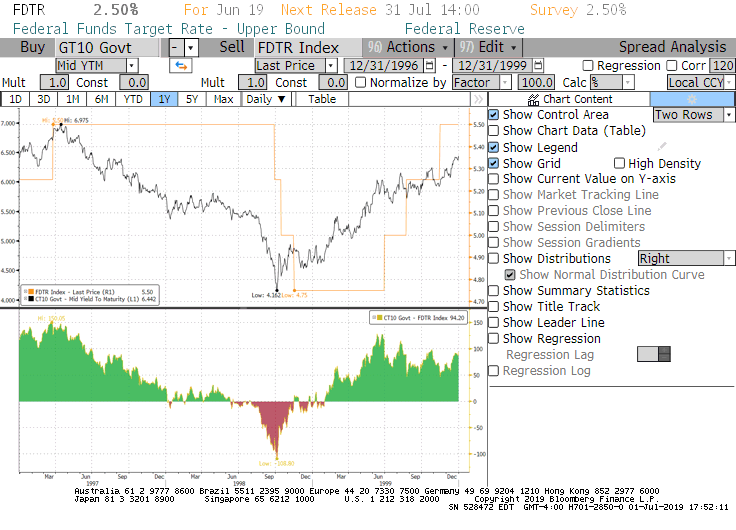
Source: Bloomberg, accessed 7/1/2019
Figure 2: 10 Year Treasury (1998-1999)
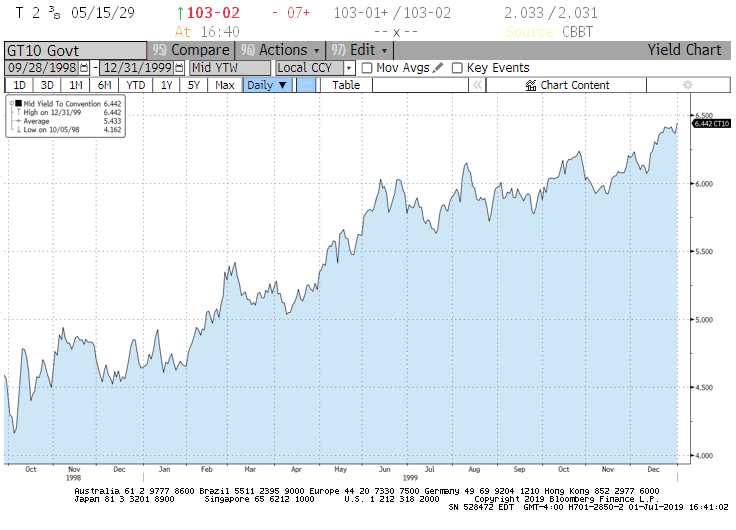
Source: Bloomberg, accessed 7/1/2019
Figure 3: S&P 500 (1998-2000)
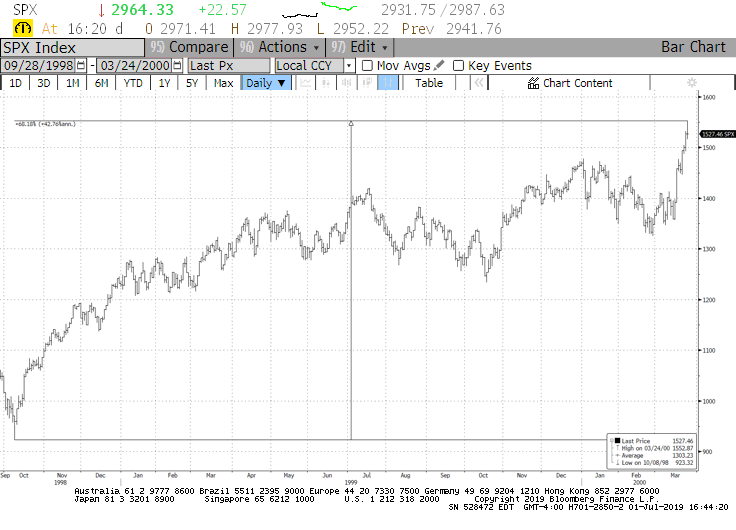
Source: Bloomberg, accessed 7/1/2019
Figure 4: US Unemployment (1990-2000)
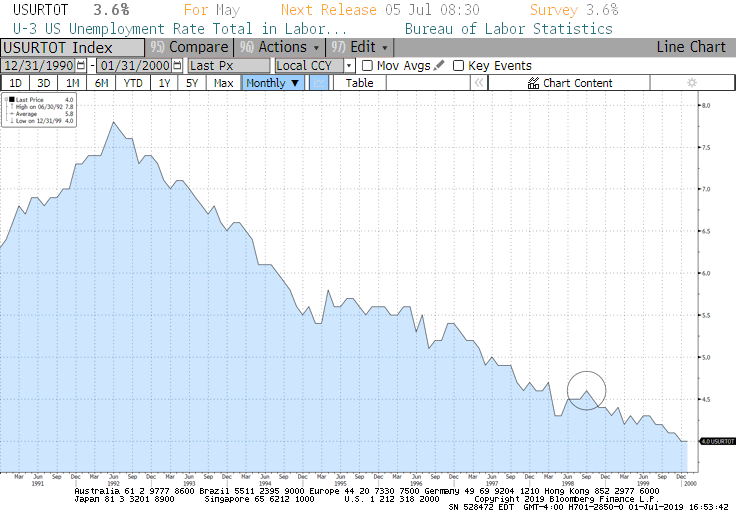
Source: Bloomberg, accessed 7/1/2019
Figure 5: CRB Commodity Index (1996-2000)
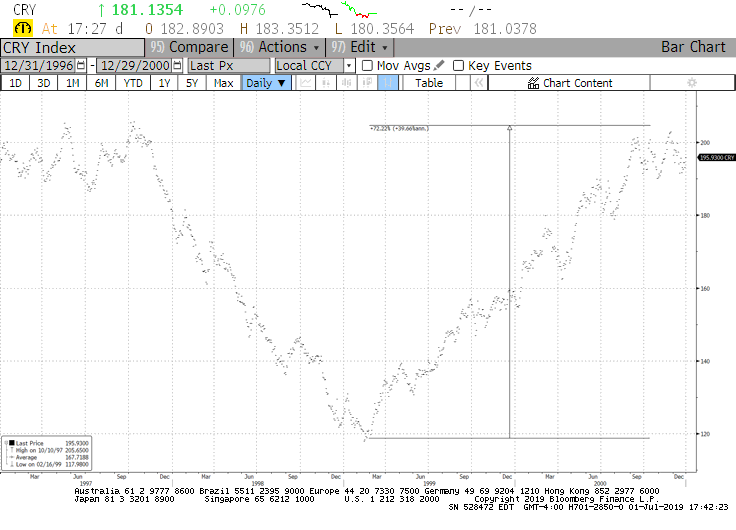
Source: Bloomberg, accessed 7/1/2019
Jonathan E. Lewis
Chief Investment Officer
INDEX DEFINITIONS
The S&P 500 is a stock market index that tracks the stocks of 500 large-cap U.S. companies.
The Commodity Research Bureau (CRB) Index acts as a representative indicator of today’s global commodity markets. It measures the aggregated price direction of various commodity sectors.













